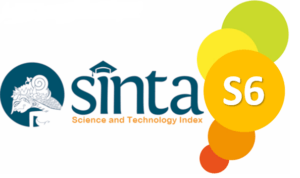Author Guidlines
Manuscript Preparation
Manuscripts in MS Word or PDF format (generated from MS Word) must be submitted to the Journal Of Management Analytical and Solution (JOMAS) via the Online Submission System by accessing the JoCAI portal (https://talenta.usu.ac.id/jomas). The length of the manuscript is expected not to exceed 25 printed pages (1.15 line spacing) including abstracts, figures, tables and references. The abstract must describe the main points of the manuscript, including the purpose of the paper, methods, results and conclusions, in 100-200 words. The author must provide 5-10 keywords or phrases that characterize the manuscript. Manuscripts are written in Indonesian (Bahasa Indonesia) and the SI system (Système International d'Unités, often referred to as "Unit Internasional") for measures and units. The body of the manuscript is written in Times New Roman font size of 10 pt with single line spacing, 6 pt spacing between paragraphs, 6 pt spacing for subsequent titles, and on A4 paper (210 mm x 297 mm) with a top margin of 2.54 cm, bottom margin 2.54 cm, left and right margins 2.54 and 2.54 cm. References must be complete, including the author's initials, paper title, date, page number, and name of the sponsoring institution.
--------------------------------------------------------------------------------------------------------------------------------------------------------------------
The Title of The Manuscript
The title of the article should be short and clear and informative. It represents the content of the research article to be discussed, which does not contain unusual abbreviations. No more than 12 words in Indonesian (Bahasa Indonesia), 14pt font size, Times New Roman, and the initial capitalization of each word in the title.
How to Write the Name and the Author’s Affiliation
The author’s name should be written without an academic degree. If the author’s name consists of at least two words, the last name should not be shorted (to avoid miss citation). If there is more than one author, the author’s names should be written separately by a comma (,). If the author’s names are only one word, it should be written as it is. The name of the author should be written in 10 pt sized font, with the italic selection as well as the left text format. The style of the author's name has been provided in MS Word Style (J.Author).
The author's affiliation should be written by providing the name of the department, faculty and university. It is written by 10pt-sized font and italic selection.
Abstract and Keywords
The abstract consist of 150-180 words and one paragraph only. The abstract should statebriefly: (i) a clear statement of the background of the study, reason study;reseacrh problem; (ii) the purpose of the study; (iii)method; (iv) the principal result; and (v) major conclusion; contribute.
The abstract is written in English. The abstract should stand alone, means that no citation in abstract. The abstract should concisely inform the reader of the manuscript’s purpose, its methods, its findings, and its value. The abstract should be relatively nontechnical, yet clear enough for an informed reader to understand the manuscript’s contribution. 🡪 (Please align writing using justify and font TNR 10 pt, single spacing). All abstracts broadly cover the following sections:
Reason for Writing- One can start with the importance of conducting their research study. Furthermore, you could start with a broader research question and address why would the reader be interested in that particular research question.
Research Problem- You could mention what problem the research study chooses to address. Moreover, you could elaborate about the scope of the project, the main argument, brief about thesis objective or what the study claims.
Methodology- Furthermore, you could mention a line or two about what approach and specific models the research study uses in the scientific work. Some research studies may discuss the evidences in throughout the paper, so instead of writing about methodologies you could mention the types of evidence used in the research.
Results- The scientific research aims to get the specific data that indicates the results of the project. Therefore, you could mention the results and discuss the findings in a broader and general way.
Inference- Finally, you could discuss how the research work contributes to the scientific society and adds knowledge on the topic. Also, you could specify if your findings or inferences could help future research and researchers.
Keywords are the labels of your manuscript and critical to correct indexing and searching. Therefore the keywords should represent the content and highlight of your article. Use only those abbreviations that are firmly established in the field. Each keyword is written by 8 pt-sized font and write alphabetically in 5-10 words.
Introduction
The introduction describes a brief background of the research, the research gap, state of the arts, and objective (s). It should be written efficiently and supported by references. It should be written without numbers and/or pointers.
The introduction must explain clearly about three things, such as: (a) The research gap; (b) The state of the art; (c) The purpose of the study (align writing using justify and font TNR 10 pt, 1.15 spacing).
Research Method
This section describes the tools of analysis along with the data and their sources. The method must explain brief, short, clear, and informative about the data and tools of analysis. 🡪 (Please align writing using justify and font TNR 10 pt, 1.15 spacing).
Results and Discussion
This section explains the results of the study. Data should be presented in Tables or Figures when feasible. There should be no duplication of data in Tables and Figures. The discussion should be consistent and should interpret the results clearly and concisely, and their significance, supported with suitable literature. The discussion should show relevance between the result and the field of investigation and/or hypotheses. Every tables and figures must explain clearly in the text (align writing using justify and font TNR 10 pt, 1.15 spasing).
Conclusion
This section concludes and provides policy implications, if any, of the study. The conclusion must be brief, clear, informative, and not exceeds than two paragraphs (align writing using justify and font TNR 10 pt, 1.15 spacing).
Acknowledgements (Optional)
Acknowledgments (optional), is gratitude to persons and/or parties who have supported the research, both in funding/facilities and thoughts. Acknowledgments are written at the end of the text before the Reference, not as the footnote of the article title (align writing using justify and font TNR 10 pt, 1.15 spacing).
References
Double check that references are in the correct format. Only those papers that are being referenced are to be included in the references section. Sources not being referenced in the text must be omitted. This section lists only the papers, books, or other types of publications referred to in the manuscript. References should be the last 10-year publication with a minimum of 80% of the journal (especially from international recognized journals). References should be listed alphabetically by the author(s) last name(s) and the year of publication. This journal use APA style 6th edition. We suggest authors to use reference management software like Mendeley, Zotero, etc., to prepare citations and the list of references (align writing using justify and font TNR 10 pt, 1.15 spacing).
Authors Biography
Briefly describe the author's biography (align text using justification and TNR 10 pt font, 1.15 spacing).














